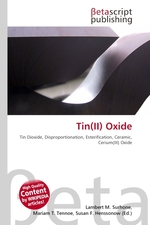Tin(II) Oxide
Lambert M. Surhone, Miriam T. Timpledon, Susan F. Marseken
бумажная книга
High Quality Content by WIKIPEDIA articles! Blue-black SnO can be prepared by heating the tin(II) oxide hydrate, SnO.xH2O (x<1) precipitated when a tin(II) salt is reacted with an alkali hydroxide such as NaOH.Metastable, red SnO can be prepared by gentle heating of the precipitate produced by the action of aqueous ammonia on a tin(II) salt.SnO may be prepared as a pure substance in the laboratory, by controlled heating of tin(II) oxalate (stannous oxalate) in the absence of air. SnC2O4 ? SnO + CO2 + CO Tin(II) oxide burns in air to form SnO2.When heated in an inert atmosphere initially disproportionation occurs giving Sn metal and Sn3O4 which further reacts to give SnO2 and Sn metal. 4SnO ? Sn3O4 + Sn Sn3O4 ? 2SnO2 + Sn SnO is amphoteric, dissolving in strong acid to give tin(II) salts and in strong base to give stannites containing Sn(OH)3?.It also dissolves in strong acid solutions to give the ionic complexes Sn(OH2)32+ and Sn(OH)(OH2)2+, and in less acid solutions to give Sn3(OH)42+.Note that anhydrous stannites, e.g. K2Sn2O3, K2SnO2 are also known. SnO is a reducing agent and this appears to its role in the manufacture of so-called "copper ruby glass".
Данное издание не является оригинальным. Книга печатается по технологии принт-он-деманд после получения заказа.


